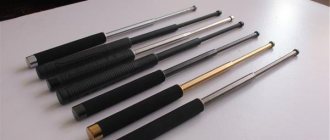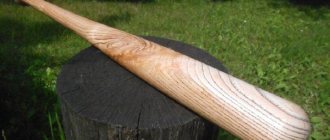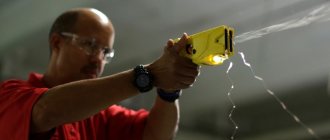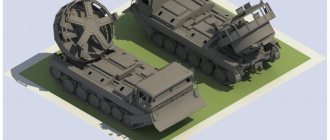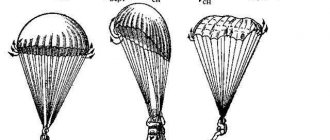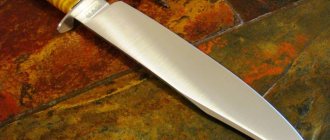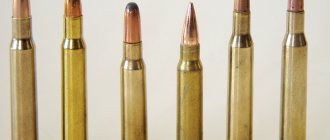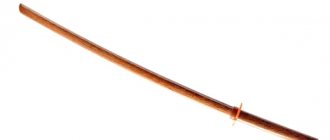The telescopic baton belongs to the class of impact-crushing weapons. In Russia, it is equated not to edged weapons, as many mistakenly believe, but to special equipment (according to the certification of police batons). There is no direct ban on wearing it (with the exception of products made of hardened steel), but if detected by law enforcement officers, questions may arise. This device can only be used for self-defense purposes.
Plastic batons
Models made of durable plastic are inexpensive and lightweight, but have good impact force. A plastic “telescope” usually consists of 2-3 retractable parts. The thinnest tube used for striking has a rubber rod inside and a strong impact tip (bolt, ball, cylinder) at the end. The thick part is the handle with a corrugated or rubberized coating.
The plastic baton quickly unfolds (with a sharp wave of the hand) and easily folds (like a telescope). The length when folded is 15-35 cm, when unfolded - 35-65 cm. Plastic bits weigh 200-500 grams. Handle thickness - 20-31 mm. Autolock or Friction Lock technology is used to prevent accidental opening. At the end of the handle there is usually a lanyard (a lanyard on the wrist).
The best are considered: Russian PUS-3, German Umarex, Chinese Wei-Shi, Czech ESP. Plastic varieties have good impact force, but can sometimes crack. When folded, they resemble an umbrella or a flashlight.
Telescopic baton for self-defense
There was a time when telescopic batons (sticks) gained popularity among people and were freely used for self-defense. We will find out in this article how legal it is at present, whether or not the use of a telescopic baton (stick) for self-defense is prohibited in Russia.
What is
A folding baton (stick) is a simple and at the same time multifunctional device, which consists of folding cylinders made of durable stainless steel or durable plastic, similar to a telescope.
The telescopic folding baton consists of several sections:
- Handles. As a rule, the handle is rubber, which ensures a secure hold in your hands.
- Sliding parts - cylinders that extend from the handle and unfold to the desired size, are tightly and securely locked in the resulting position.
- As a rule, the baton kit includes a special case with which you can attach the baton to your belt.
Thus, a telescopic baton is a folding metal structure that, when folded, has a length of up to 20 cm.
To activate the telescopic tube as a means of self-defense, it is enough to make a small swinging movement. As a result, the cylinders extend and it transforms into an elongated steel stick. To fold the structure back, the baton must be held vertically, striking the tip against a hard surface. Thanks to its compact size, the baton can be carried in a pocket or attached to a belt. Ease of use and reliability have made such batons a popular weapon for self-defense, but we will find out how legal this is further.
Application
It is actively used as self-defense, as it helps limit the enemy’s combat capability. It is enough to know a few self-defense techniques using a baton to be able to disarm your opponent.
The very fact of surprise and unexpectedness is an advantage of this weapon. At the same time, it is quite difficult to kill a person with a telescopic baton, but it can cause serious injuries. This multifunctional design is actively used in the armed forces, police forces and other law enforcement agencies. A hardened telescopic baton is almost a mandatory attribute of a professional as a means of self-defense.
You may also be interested in the following:
Hunting
Self-defense
Clothes and shoes
To find out all the information you are interested in, please contact us by phone or email.
Banned or not
The telescopic baton, recently patented in Russia, can prove to be an indispensable assistant in many situations in which self-defense is required. Despite this, any type of baton is prohibited for free use, since it belongs to the class of bladed weapons.
In accordance with the Federal Law of the Russian Federation “On Weapons” of 1996. (You can download it here) storage, transportation and use on the territory of Russia of impact-crushing objects used as weapons is prohibited.
Folding batons are used both for self-defense and as weapons. Thus, they can be confiscated by internal affairs bodies. However, if a baton is used solely for the purpose of self-defense, its owner will be given a verbal warning by law enforcement officials, an administrative fine will be issued, or the weapon will be confiscated.
The use of this weapon will be taken into account as an aggravating circumstance in the investigation of a criminal case. Accordingly, criminal liability is applied for the manufacture and sale of this device, and administrative liability for wearing it.
Expandable batons are quite common and can be purchased on the black market. You can find different types of batons - kinetic, pneumatic, inertial.
Rubber
Typically, rubber batons have a monolithic (not folding) design (PR-73, PR-73M, “Argument”). Solid rubber poles are flexible, but too bulky. In contrast, telescopic models - "Surprise", PR-89, PUS-3 - are more compact, as they fold and consist of 2 retractable parts. The length when extended is about 50-60 cm, when folded - 30-45 cm. The weight of such a “telescope” is 500-600 grams.
Bits made of rubber are flexible, low in price and have good impact force.
The only negative is that the retractable tubes have poor fixation.
Characteristics of TF-24/59
The TF-24/59 police rubber baton is widely used by police in many countries around the world, so its data will be considered.
| TF-24/59 | PUS-2 | |
| Material | Polypropylene | Polypropylene |
| Size (total) | 590 mm | 480 mm or 650 mm |
| Weight | 510 g | 480 g or 650 g |
| Cross handle | 125 mm | 130 mm |
| Longitudinal handle | 135 mm | 130 mm |
| Diameter | 28 mm – 31 mm | 32 mm |
From this it can be seen that the weapon (TF-24/59) is compact and has nothing in common with the crutch. Its Russian analogue PUS-2 “Argument”, the name of which seems to hint at the seriousness of its intentions, differs only in the absence of a heart-shaped element for protecting the hand, that is, an extension for the longitudinal handle.
PUS-2 is a really good argument in favor of the police in street fights and other showdowns. But according to the legislation of the Russian Federation, the civilian population does not have the right to use the democratizer for its intended purpose.
But it is worth noting that this baton was created with the support of the police of the Czech Republic and Poland and is now used in many European countries.
Steel
The most popular are telescopic batons made of steel or steel alloy. Hardened metal is a durable and inexpensive material with high performance qualities. Steel bats usually consist of 2-3 retractable parts.
Length when folded is 20-35 cm, when extended - 50-65 cm. Locking - Friction Lock, Camlock or Autolock . At the end of the striking part there is a heavy tip (washer, cylinder). The handle has a rubber coating and a lanyard. Weight - about 0.5 kg.
Popular “telescopes” made of steel: German Umarex, American Mace and ASP, Czech ESP. The Chinese Nextorch stick when folded looks like a flashlight. The main advantages of steel bats are high strength and powerful impact force. The only drawback: the steel model usually causes disapproval from the police.
Baton (rubber stick) PG-M - a legal means of self-defense
Police officers, security personnel, and correctional institutions are armed with rubber truncheons, which are not capable of causing fatal damage, but can subdue someone who is too excited. The baton PG-M (in Ukrainian, Russian version PG-R) is one of the common options for such equipment. This model is produced by the Fort research and production association from the city of Vinnitsa (Ukraine).
Pros:
- Inability to cause significant harm to a person.
- The product can be purchased freely, no permission is required.
- Thanks to the rubber flexibility of the baton, it increases the energy of impact during swing and impact.
- If you hit him on the head with a rubber stick, it will not be fatal.
Minuses:
- Quite large dimensions and decent weight - not very convenient to carry around.
- If the attacker is too aggressive and assertive (or there are several attackers), then it is difficult to defend with one baton.
- Often it is necessary to have time to make a pre-emptive strike - sometimes the speed of reaction may not be enough.
- During a street fight there may not be enough toughness.
Purpose, operating principle
- This item is designed to protect against blows, as well as inflict them.
- He is also able to hold the enemy and control him.
- In addition to law enforcement officers, civilians also buy batons for self-defense.
Of course, it’s strange to carry such an accessory with you, but in a car it won’t be at all out of place.
Rubber baton PG-M
Construction of a baton (rubber stick) PG-M
This one-piece model is molded from a rubber compound in the form of a rod, and has a dedicated handle and a belt loop for easy carrying. Thanks to the loop, the handle does not slip out of the hands of the baton owner.
Options and packaging
The kit includes the baton itself (in other words, a rubber stick) with a belt loop threaded through special holes in the upper part of the handle. If desired, you can additionally order a leather holder that allows you to carry the accessory on your belt.
The packaging is polyethylene. Instructions in Ukrainian are included.
How to use
- A rubber stick can significantly increase the leverage of the hand, moving away from the enemy and preventing him from, for example, making a grab or using a knife. Optimally, while moving, deliver swinging blows to the limbs.
- When attacking, it is necessary to carry out preemptive strikes. For example, when the enemy is about to attack, but he himself does not expect the attack. Or he is going to use a knife, a broken bottle, or a stick.
- It is convenient to hit your hand when gripping the knife to knock it out. After the strike, you should retreat to a safe distance. Having, in addition to a baton, also a shield, you can act more effectively.
We also separately talk about the correct use of a rubber baton for protection, and also give permitted blows with such a stick.
Read below about the price of such special equipment as rubber sticks.
This video will tell you how to use the PG-M rubber stick correctly:
Analogs
Examples include the following models:
- RDU-50 (Russian production) 50 centimeters long, weighing 700 grams and 3 centimeters in diameter. Costs 300 rubles.
- PR-73 or PR-73M (also from a Russian manufacturer. It has a length of 65 to 70 centimeters, a diameter of 3 or 3.2 centimeters, weight 700 or 750 grams.
- PR-13 (Ukrainian) has a length of 46 centimeters and costs about 105 hryvnia.
- Tonfa also performed well (24-59).
This video will tell you about the use of the PG-M rubber stick and its analogues:
Spring models
Some steel batons resemble a spring with a rod inserted inside, which is why they are called spring batons. Such models usually consist of 2-3 sections. The handle (lower part) is plastic or rubber. At the end of the upper spring shock section is a durable tip. Weight - 300-500 grams. Length when extended - 45-65 cm, when folded - 20-30 cm.
The best spring “telescopes”: Chinese Wei Shi, Hong Kong KUNWOO or Kung Long. Such tubes are flexible, durable, and have good impact force. Spring poles are cheaper than steel poles. True, it will not be possible to cause serious damage with their help. But a stick that resembles a spring is unlikely to arouse suspicion among law enforcement officers.
Legal status
Russian legislation contains a rule on acceptable self-defense, including the use of special means, which include a baton. The legislator regulates the limit of self-defense, limiting the actions of the defending citizen to the degree of threat from the attacker.
This means that in an attempted theft, using a baton on the thief and causing moderate or severe injury will result in criminal prosecution for the defender.
Defense with a baton should pursue the principle of sufficiency, which means removing the threat and neutralizing attacks on property and the life and health of a citizen.
Therefore, when using a baton for an attacker, the degree of threat and the possible consequences of using such a weapon should be assessed. A baton in the hands of a citizen is capable of inflicting injuries incompatible with life to the attacker and, provided there is no direct threat to life (an attack on a citizen using bladed weapons or firearms, statements and murderous intentions against a citizen), a person who will inflict injuries incompatible with life on the attacker, which will entail his death - will suffer criminal punishment for exceeding the limits of necessary self-defense.
Modern telescopic batons that can cause irreparable damage to an attacker
